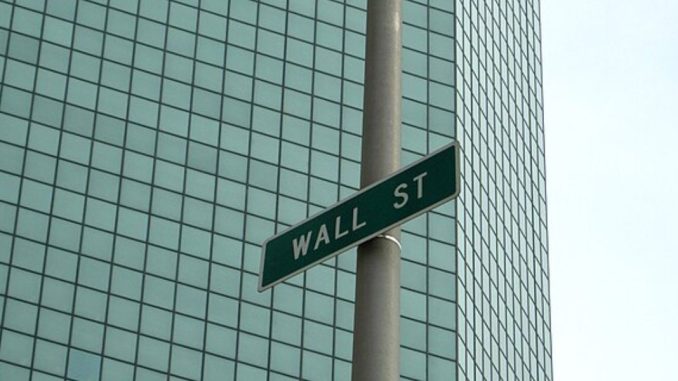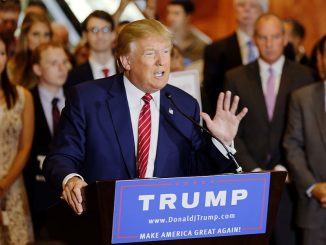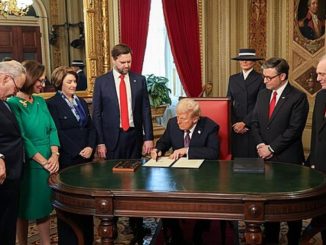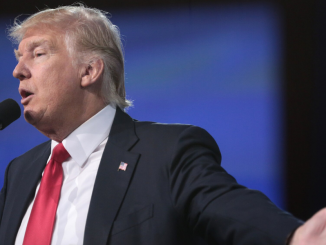
Three Key Takeaways:
- President Donald Trump declared a national emergency and imposed sweeping tariffs on foreign imports, including a baseline 10% tariff and higher rates for countries with trade surpluses with the U.S., starting April 5.
- The new tariffs target countries like China, the European Union, and Vietnam, with the goal of addressing unfair trade practices and boosting America’s manufacturing base, which has been undermined by previous administrations.
- Trump’s policy emphasizes reciprocity in trade, aiming to level the playing field for U.S. companies, and is positioned as a response to the growing trade deficit under the Biden administration.
Donald Trump is wasting no time implementing his America First agenda in his second term.
And other countries aren’t happy about it.
Donald Trump stunned Wall Street when he dropped this bombshell about foreign trade.
Trump declares national emergency to impose sweeping tariffs
President Donald Trump declared a national emergency on Tuesday to address what he called a “hollowing out of our manufacturing base” caused by years of unfair foreign trade practices.
The sweeping executive order will impose a baseline 10% tariff on all imported goods starting April 5, with higher “reciprocal” tariffs on specific countries that maintain large trade surpluses with the United States.
“So the tariffs will be not a full reciprocal – I could have done that, yes, but it would have been tough for a lot of countries. We didn’t want to do that,” Trump explained during a White House announcement.
Some countries will face substantial tariffs under the new policy:
- China: 34% (down from their 67% effective rate on U.S. goods)
- European Union: 20% (down from their 39% rate)
- Vietnam: 46% (down from their 90% rate)
- Taiwan: 32% (down from their 64% rate)
- Japan: 24% (down from their 46% rate)
- Cambodia: 49% (down from their 97% rate)
“You have to understand – we charge them almost nothing for years and years and decades, and it was only seven years ago when I came in – we started with China, charged them – we took in hundreds of billions of dollars from China in tariffs, and they understood,” Trump said.
The executive action invokes Trump’s authority under the International Emergency Economic Powers Act (IEEPA), the same law he used earlier to impose tariffs on Mexico and Canada over border security and fentanyl trafficking.
Trump says reciprocity is the “Golden Rule” for trade
The White House released a fact sheet calling the policy the “Golden Rule for Our Golden Age,” emphasizing that “access to the American market is a privilege, not a right.”
Trump’s Commerce Secretary, Howard Lutnick, displayed charts showing the tariff disparities between the U.S. and its trading partners during the announcement.
“I don’t blame the people for doing it. I think they’re very smart in doing it – I blame the people that sat right in that Oval Office right over there, right behind the Resolute Desk or whichever desk they chose,” Trump said, taking a shot at previous administrations.
The administration claims the U.S. has among the world’s lowest tariff rates at just 3.3%, while major trading partners like Brazil (11.2%), China (7.5%), and India (17%) impose much higher rates on American goods.
Trump also criticized value-added taxes (VAT) imposed by foreign governments, which the White House estimates cost U.S. companies over $200 billion annually.
The White House fact sheet states that this creates a “double-whammy” on U.S. companies who “pay the tax at the European border, while European companies don’t pay tax to the United States on the income from their exports to the U.S.”
Biden blamed for record trade deficits
Trump’s executive order directly criticizes the Biden administration for turning the agricultural trade surplus Trump had established in his first term “into a projected all-time high deficit of $49 billion.”
The fact sheet also claims America’s overall trade deficit in goods “exceeded $1.2 trillion” in 2024, which it called “an unsustainable crisis ignored by prior leadership.”
Trump’s action exempts several categories of goods from the new tariffs, including steel and aluminum already subject to Section 232 tariffs, pharmaceuticals, semiconductors, and energy products not available domestically.
For Canada and Mexico, existing IEEPA orders related to fentanyl and migration remain in effect, meaning “USMCA compliant goods will continue to see a 0% tariff, non-USMCA compliant goods will see a 25% tariff, and non-USMCA compliant energy and potash will see a 10% tariff.”
Japan’s Prime Minister, who recently visited Washington, D.C., appeared to have received advance warning about the tariffs.
“The Prime Minister just left, and he’s a great friend of mine, but I said, ‘You’re a friend of mine, but you’re not treating us right,'” Trump revealed.
The administration is defending the move against inflation concerns by citing former Biden Treasury Secretary Janet Yellen, who according to the White House fact sheet said last year: “I don’t believe that American consumers will see any meaningful increase in the prices that they face.”
Trump also referenced the late Japanese Prime Minister Shinzo Abe, saying, “I went to him, and I said, ‘Shinzo, we have to do something – trade is not fair.’ He said, ‘I know that, I know that,’ and he was a great gentleman – he was a fantastic man.”
The White House claims a 2024 economic analysis found that a global 10% tariff “would grow the economy by $728 billion, create 2.8 million jobs, and increase real household incomes by 5.7%.”
The tariffs will take effect in two stages, with the baseline 10% starting April 5 and the country-specific rates beginning April 9.



